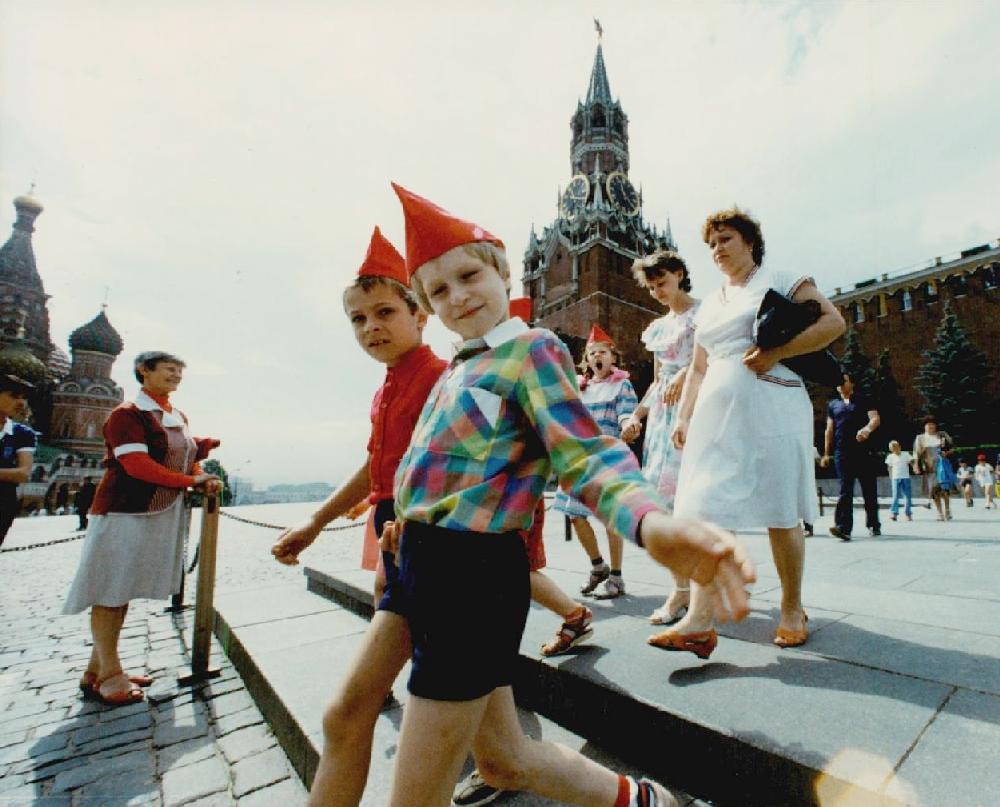
Russian Boys' Activities: Patriotic Outings--Red Square

Figure 1.-- here we see Soviet school children visiting Red Square in the last years of the Soviet Union (1989). They are not wearing their school uniforms, but are wearing Pioneer caps. You can see St. Basil's Cathedral to the left and the clock tower of the Kremlimn to the right. The photigraph is dated June 27, 1989.
|
|
Red Square (Кра́сная пло́щадь) is arguably the most famous city square (plaza) in the world. The name suggests Soviet origins. A Bolshevik leader Vladamir Lenin in life and death dominates the square. In fact it has a long history, going back centuries before the Lenin and the Bolsheviks. It was constructdt directly east of the Kremlin. The square is located between the Kremlin, the royal fortress and now the official residence of the President of Russia, from a long established merchant quarter known as Kitai-gorod. Red Square is commonly seen as the central square of Moscow. The Kremlin is Moscow’s historic fortress and the center of the Russian government. And Red Square is is where some of Rusia's most distinctive and important landmarks are located. Moscow's major streets basically radiate from the Square and connect to Russia's major highways. The name Red Square has nothing to do with the revolutionary red banners of the Bolsheviks. Nor do they refer to the reddish pigmentation of the bricks used to build the Kremlin. (Actually the bricks were whitewashed during important historical periods.) Apparently it was a pnemonic accident with no historical significance. The Russian language word красная (krasnaya), which means 'red'. It sounds rathr like the word ('krasivaya') meaning 'beautiful'. It began to be used for a small area between St. Basil's Cathedral, the Spassky Tower of the Kremlin, and the herald's platform called Lobnoe Mesto. It never was a place of execution with blood flowing as some believe. The origins of the Square date back to the late 15th century, when the Muscovite prince Ivan III/Ivan the Great (1462–1505) began enlarging the Kremlin to reflect Moscow’s growing power. The area had been an important public marketplace and meeting place for centuries. The important Tsar Alexei Mikhailovich (1645-1676) officially began using the term for all of the square. This was an area that had been called Pozhar or 'burnt-out place' reffering to its origins. The Russians had to burn down several old wooden struftures to create space for the square. This was not unuusal. Several ancient Russian and Uranian towns (Suzdal, Kiev, Yelets, and Pereslavl-Zalessk) have main square named Krasnaya ploshchad.
Important histrical events have occurred in Red Square and have been meoralized in painings by Russian artists (Vasily Surikov, Konstantin Yuon and others. The square like other European cty squares was the city's main marketplace. It came to be the site where various public ceremonies were held and major proclamations held. Some Tsars werre coonated in the Square. Over time the square has been built up and used for official ceremonies by all Russian governments, includiung Tsarist, Soviet, and the modern Russian Federation. Red Square houses the ornate 16th-century St. Basil’s Cathedral, the State Historical Museum, and the huge GUM Department Store. A key feature is the modernist mausoleum for the Bolshevik revolutionary leader Vladimir Lenin. Lenin was entombed there in a mosoleum. Soviet Leaders would stand on Lenin's tomb and inspect the annual massive military parade and other demonstrations that became a Soviet tradition. So little was known avout Soviet politics that their arrabgemenbt in Lenin's tomb would be the porimay indicator of leadership status. How close Soviet keaders stood to Stalin and hus successors was a measure of their importance., Red Square becanme the most important tourirt attraction in Moscow and visited by generations of Soviet and modern Russian school children.
HBC

Navigate the Boys' Historical Clothing Web Site:
[Return to the Main Russian activity page]
[Introduction]
[Activities]
[Biographies]
[Chronology]
[Clothing styles]
[Countries]
[Girls]
[Topics]
[Bibliographies]
[Contributions]
[FAQs]
[Glossaries]
[Images]
[Links]
[Registration]
[Tools]
[Boys' Clothing Home]
Navigate the Historic Boys' Clothing Russian pages:
[Ballet]
[Children's literature]
[Choirs]
[Fashion magazines]
[Movies]
[Royalty]
[School uniform]
[Youth groups]
Navigate the Boys' Historical Clothing Web Site:
[Return to the Main Russian country page]
[Return to the Main country page]
[Australia]
[Canada]
[England]
[France]
[Germany]
[Ireland]
[Italy]
[Mexico]
[New Zealand]
[Poland]
[Scotland]
[United States]
Created: 8:24 PM 4/14/2009
Last updated: 4:04 PM 8/27/2018



